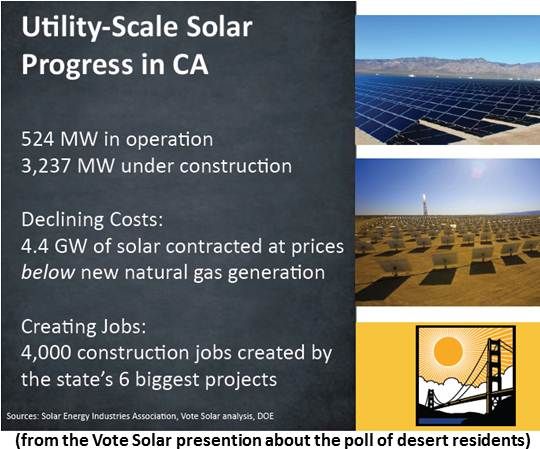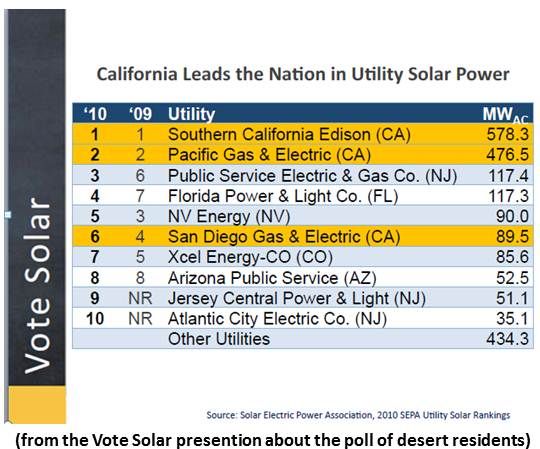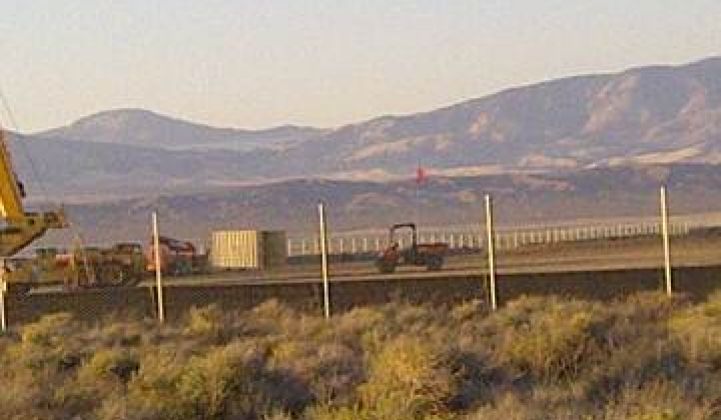Grumbling in California’s Antelope Valley about utility-scale wind and solar is evolving into a mainstream political resistance movement.
A recent Vote Solar poll of desert communities found overwhelming approval for utility-scale solar development, but did not include renewables-rich Los Angeles County and did not adjust for the proximity of respondents to proposed projects. These could be serious oversights.
L.A. County’s Western Antelope Valley (WAV) is part of California’s ripest renewable energy zone. The sun shines there more than 300 days a year and the wind blows during peak demand periods, often bending trees sideways. Southern California Edison and the Los Angeles Department of Water and Power are expanding nearby transmission systems and nearby cities are hungry for renewables-generated electricity.
Joint management of a sizable benefits offer from a solar power plant developer has led to reconciliation between the region’s three key town councils.
But scattered opposition groups, often branded NIMBYs by outside observers, have had some success in blocking developers’ efforts to permit and build in the WAV.
Billions in federal loan guarantees, tens of billions in private investment and thousands of green jobs, not to mention California’s leadership in the nation’s fight against climate change and foreign oil dependency, are at stake. Still, there remains an increasingly organized resistance to wind and solar development.

Resistance that blocks access to development of the WAV’s resources could be a key setback both for Governor Jerry Brown’s ambition to obtain a third of the state’s power from renewables by 2020 and to California’s ambitious wind and solar developers.
The focus remains on First Solar’s 230-megawatt Antelope Valley Solar Ranch One (AVSR1), the first of dozens of proposed large scale wind and solar projects to reach the construction phase. Less-than-graceful efforts by the company to respond to locals’ concerns about safety and environmental impacts have produced repeated charges that First Solar is insensitive to and abusive of community values.
WAV opponents of development were excited when the Wall Street Journal reported on February 11 that AVSR1 was on the verge of a regulatory delay that, the Journal said, could invalidate the solar power plant’s construction permit and “derail First Solar's $1.36 billion power-plant sale to Exelon.” This speculation was, however, inaccurate.
On February 14, L.A. County cleared First Solar’s permit, construction continues, and no impediment to the loan guarantee process or to the transfer of AVSR1 from First Solar to Exelon remains.
NextEra Energy, the nation’s biggest wind developer, and Element Power (EP), another large national player, are among those proposing major WAV renewables projects. NextEra wants to build Blue Sky, a 200-megawatt wind installation. EP wants to build Wildflower, a 250-megawatt hybrid wind-solar installation.
WAV activists responded to the prospect of utility-scale wind turbines on their landscape by successfully lobbying for denial by L.A. County of meteorological towers needed by NextEra and EP. Without meteorological data, financial institutions will not provide the required hundreds of millions of dollars in project financing and the projects cannot be built.
As NextEra and EP were being waylaid by the activists, First Solar was holding a joint meeting of the area town councils and, in a genuine effort at bridge-building, offering the gathered representatives -- in addition to the six $10,000 gifts it had already made to local organizations like 4H Clubs -- a $280,000 package of community benefits.
This series of events catalyzed a new anti-development movement.

The activists, fresh off their success against the wind builders, responded at a town council meeting to the First Solar offer. One called First Solar’s offer “blood money” and suggested the community should “take the money, put it in a barrel, and burn it.” Such words came as a slap in the face to town council leaders who had worked hard to get what benefits for the community they could from First Solar.
And then three things happened.
First, Town Council members from the three involved communities noticed nearby Riverside County’s proposed $450 per acre fee on solar power plant developers. The fee, which would be assessed to compensate affected localities, made WAV leaders wonder why First Solar’s benefits offer was so relatively small.
At the same time, more seasoned members of the activist group, whose success against the wind developers was due in part to a growing ability to work within the L.A. County system, brought their new political skills to town council meetings.
Finally, previously uninvolved citizens, intimidated by tales of dread told about utility-scale wind, began turning up at Town Council meetings to acknowledge the activists’ efforts and staying for debates about how the First Solar money should be used.
The ongoing dialogue is a debate between those who demand distributed generation only and those who accept the inevitability of some utility-scale solar but refuse wind. It is a tentative alignment among contentious and strong-willed desert community members. Those who would see renewable energy expanded in the WAV had better arrive ready to confront it.



